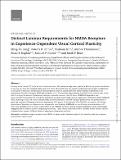| dc.contributor.author | Fong, Ming-fai | |
| dc.contributor.author | Finnie, Peter Sb | |
| dc.contributor.author | Kim, Taekeun | |
| dc.contributor.author | Thomazeau, Aurore | |
| dc.contributor.author | Kaplan, Eitan S | |
| dc.contributor.author | Cooke, Samuel F | |
| dc.contributor.author | Bear, Mark F | |
| dc.date.accessioned | 2021-11-05T18:56:51Z | |
| dc.date.available | 2021-11-05T18:56:51Z | |
| dc.date.issued | 2019-12-12 | |
| dc.identifier.issn | 1047-3211 | |
| dc.identifier.issn | 1460-2199 | |
| dc.identifier.uri | https://hdl.handle.net/1721.1/137580 | |
| dc.description.abstract | © 2020 Oxford University Press. All rights reserved. Primary visual cortex (V1) is the locus of numerous forms of experience-dependent plasticity. Restricting visual stimulation to one eye at a time has revealed that many such forms of plasticity are eye-specific, indicating that synaptic modification occurs prior to binocular integration of thalamocortical inputs. A common feature of these forms of plasticity is the requirement for NMDA receptor (NMDAR) activation in V1.We therefore hypothesized that NMDARs in cortical layer 4 (L4), which receives the densest thalamocortical input, would be necessary for all forms of NMDAR-dependent and input-specific V1 plasticity.We tested this hypothesis in awake mice using a genetic approach to selectively delete NMDARs from L4 principal cells.We found, unexpectedly, that both stimulus-selective response potentiation and potentiation of open-eye responses following monocular deprivation (MD) persist in the absence of L4 NMDARs. In contrast, MD-driven depression of deprived-eye responses was impaired in mice lacking L4 NMDARs, as was L4 long-term depression in V1 slices. Our findings reveal a crucial requirement for L4 NMDARs in visual cortical synaptic depression, and a surprisingly negligible role for them in cortical response potentiation. These results demonstrate that NMDARs within distinct cellular subpopulations support different forms of experience-dependent plasticity. | en_US |
| dc.language.iso | en | |
| dc.publisher | Oxford University Press (OUP) | en_US |
| dc.relation.isversionof | 10.1093/cercor/bhz260 | en_US |
| dc.rights | Creative Commons Attribution NonCommercial License 4.0 | en_US |
| dc.rights.uri | https://creativecommons.org/licenses/by-nc/4.0/ | en_US |
| dc.source | Oxford University Press | en_US |
| dc.title | Distinct Laminar Requirements for NMDA Receptors in Experience-Dependent Visual Cortical Plasticity | en_US |
| dc.type | Article | en_US |
| dc.identifier.citation | Fong, Ming-fai, Finnie, Peter Sb, Kim, Taekeun, Thomazeau, Aurore, Kaplan, Eitan S et al. 2019. "Distinct Laminar Requirements for NMDA Receptors in Experience-Dependent Visual Cortical Plasticity." Cerebral Cortex, 30 (4). | |
| dc.contributor.department | Picower Institute for Learning and Memory | |
| dc.contributor.department | Massachusetts Institute of Technology. Department of Brain and Cognitive Sciences | |
| dc.relation.journal | Cerebral Cortex | en_US |
| dc.eprint.version | Final published version | en_US |
| dc.type.uri | http://purl.org/eprint/type/JournalArticle | en_US |
| eprint.status | http://purl.org/eprint/status/PeerReviewed | en_US |
| dc.date.updated | 2021-03-11T18:10:41Z | |
| dspace.orderedauthors | Fong, M-F; Finnie, PS; Kim, T; Thomazeau, A; Kaplan, ES; Cooke, SF; Bear, MF | en_US |
| dspace.date.submission | 2021-03-11T18:10:43Z | |
| mit.journal.volume | 30 | en_US |
| mit.journal.issue | 4 | en_US |
| mit.license | PUBLISHER_CC | |
| mit.metadata.status | Authority Work and Publication Information Needed | en_US |
